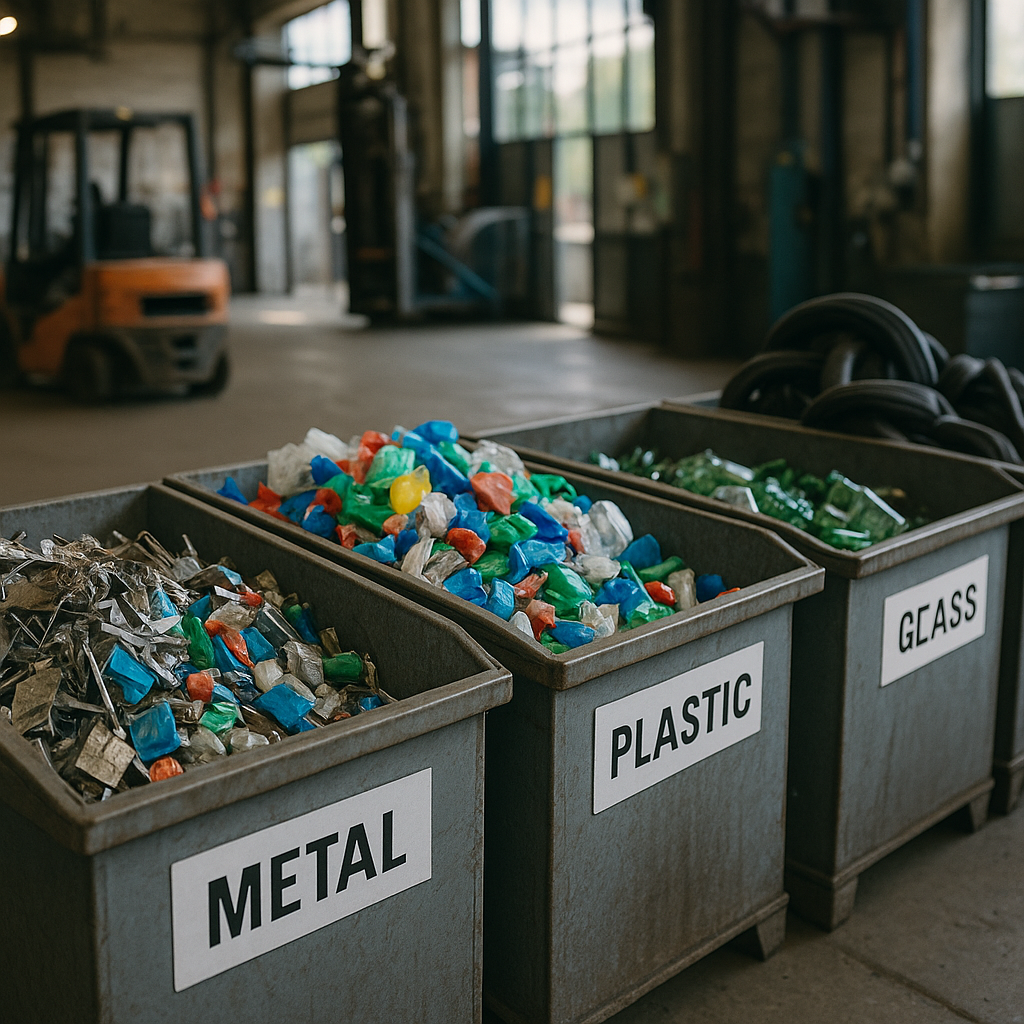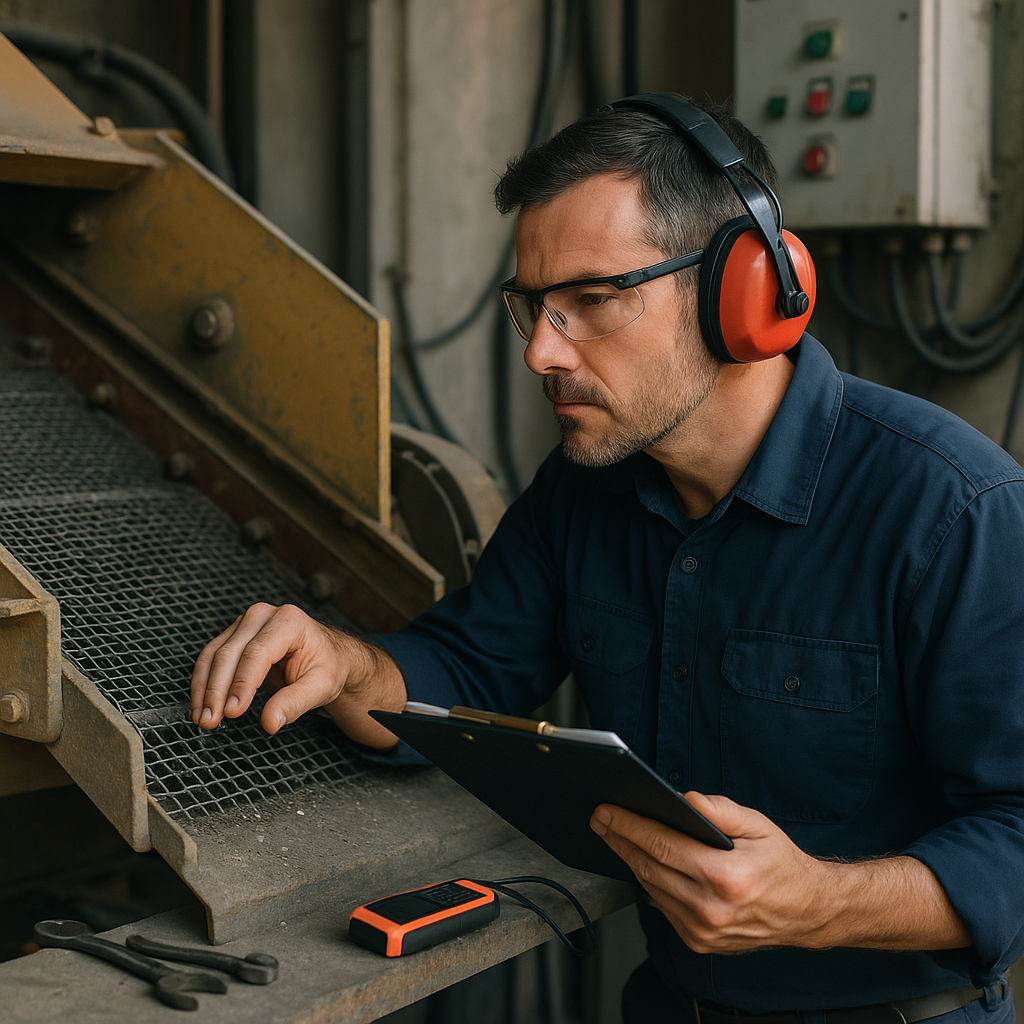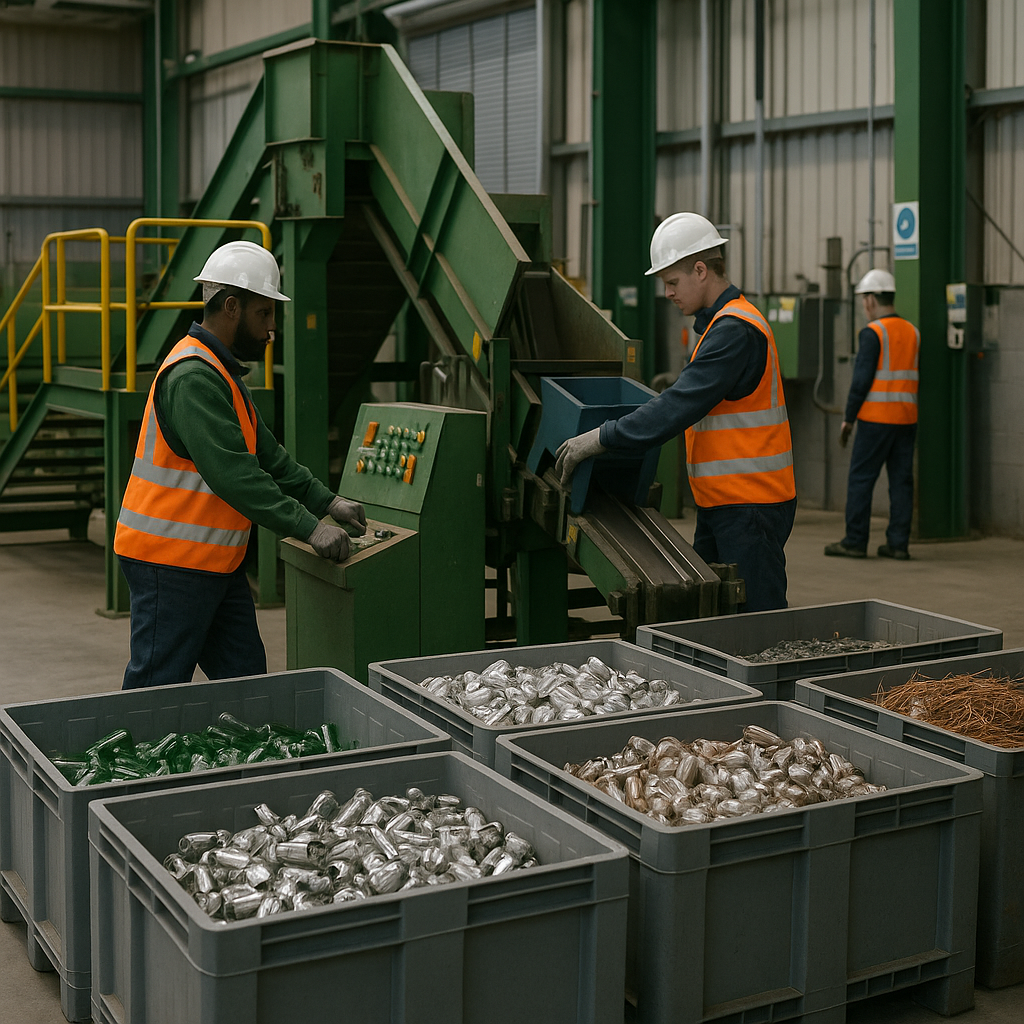5901 Botham Jean Blvd, Dallas, TX 75215
How a Vibrating Screen for Scrap Separation Works: A Process Guide
November 6, 2025Mixed scrap materials present a significant challenge in recycling. When metals, plastics, electronics, and organic waste arrive together at processing facilities, efficient separation determines whether valuable materials are recovered or lost to landfills. This complexity in sorting has made vibrating screens essential equipment in the waste management industry.
A vibrating screen for scrap separation is industrial equipment designed to classify and sort particles by size. Based on the principle of transferring vibrations to a screening surface, these machines break down surface tension between particles, forcing them to separate according to predetermined size specifications. The vibrating motion creates a “popcorn effect,” where larger materials bounce higher while smaller particles remain closer to the screen surface.
These vibratory screen separators are crucial in recycling and waste management sectors for effectively separating materials like metals, plastics, and e-waste from mixed waste streams. Whether processing single-stream recyclables or construction demolition debris, vibrating screens improve scrap metal quality and processing efficiency while reducing manual labor. Their capacity to handle high-volume material flows makes them especially valuable for facilities requiring rapid, reliable material classification to meet sustainability compliance standards.
What Are The Common Types Of Vibrating Screens For Scrap?

Vibrating screens work by creating controlled vibrations that reduce surface tension between particles. This process allows smaller materials, known as fines, to fall through the screen media while larger particles move across the surface. The screening process efficiently sorts different materials based on particle size separation.
The vibration mechanism causes materials to stratify by size and density. Smaller particles settle towards the screen surface and pass through openings, while larger materials remain on top and move forward along the deck. This principle is fundamental to all vibrating screen designs used in scrap processing operations.
Linear Vibrating Screens
Linear vibrating screens use straight-line motion to move materials across the screen surface. Twin out-of-balance motors create vertical and forward movements simultaneously. This design excels at processing fine to medium-sized scrap materials with consistent throughput rates.
The horizontal screen configuration allows for multiple deck installations. It enables stacking two or three screening levels to achieve different particle size separations in a single pass. Linear motion provides excellent material conveyance and higher processing capacity compared to other screening types.
Circular Vibrating Screens
Circular vibrating screens generate a spiral motion using centrifugal force. This rotary vibrating screen design combines horizontal and vertical movement components. This motion achieves high purity rates in sorting applications by providing intensive material agitation.
The circular motion pattern works exceptionally well for difficult materials that tend to blind traditional screens. These screens are often selected for applications requiring precise particle size separation. The design effectively handles both wet and dry materials while maintaining consistent screening performance.
Specialized Screen Designs
Inclined vibrating screens operate at angles between 15 and 30 degrees. Gravity assists in the screening process, enabling higher capacity processing with reduced power consumption. These screens are effective for initial scalping operations in scrap yards.
High-frequency vibrating screens operate at 1500 to 9000 RPM for fine material separation. The elevated frequency generates intense vibration that prevents screen media blinding. These screens are used for processing materials smaller than 200 microns in specialized applications.
Grizzly screens feature parallel bars or grids instead of traditional screen media. These robust designs remove oversized materials before they reach primary crushers. The bar spacing determines the maximum size of materials that pass through to downstream equipment.
Each screen type serves specific functions in scrap processing operations. Linear screens provide consistent throughput for general sorting applications. Circular designs handle challenging materials that require intensive agitation. Specialized screens, such as grizzly and high-frequency models, address unique processing requirements within comprehensive recycling systems.
What Kinds Of Scrap Materials Can These Screens Separate?

Vibrating screen separators are highly versatile in handling diverse scrap materials commonly found in e-waste recycling operations. These machines efficiently process both solid components and fine powdered materials resulting from various waste activities. The separation capabilities largely depend on particle size, density differences, and specific mesh configurations used in the screening systems.
Material characteristics significantly impact separation effectiveness. Dense metals behave differently from lighter plastics during the vibrating process, allowing precise sorting based on physical properties. The screens can handle materials ranging from large solid components several inches in size to fine powders measured in microns.
Solid Materials
Circuit boards are among the most valuable solid materials these screens can effectively separate. Vibrating screen separators sort circuit boards based on size and density, accurately handling different thicknesses and irregular shapes. The screens accommodate the varied dimensions typical of electronic components while ensuring separation from other waste streams.
Metal frames from electronic devices, often made of aluminum, steel, or other metals, are another significant category of solid materials. These frames separate cleanly from plastics and other non-metallic components during screening. The vibrational action helps dislodge any attached materials, preparing the metal frames for subsequent recycling processes such as melting or refinement.
Plastic housings present challenges due to their varying sizes and material properties. These components originate from computers, televisions, mobile devices, and other electronic equipment. The screens sort plastic housings by size, and the vibrating motion helps remove adhered components or contaminants, preparing them for downstream processes like shredding or melting.
Powdered Materials
Fine powders containing valuable metals offer a crucial recovery opportunity in e-waste recycling. Copper powder, generated through crushing operations or material wear, can be effectively separated with appropriately sized mesh screens. The vibrating action ensures that only specific-sized particles pass through designated openings, allowing for precise recovery of valuable copper materials.
Silver powder and other precious metal particles require careful handling due to their high value and small sizes. Screens can be configured with extremely fine mesh openings to capture these materials while allowing less valuable particles to pass through, maximizing recovery from e-waste processing.
The capability to adjust mesh size is essential for powdered material separation. Screen openings can be modified to target specific particle size ranges, ensuring optimal recovery rates for different metal powders. This flexibility allows the same equipment to meet various powder separation requirements within a single facility, enhancing operational efficiency and minimizing capital equipment needs.
What Key Factors Determine Screening Accuracy?

Screening accuracy determines how effectively a vibrating screen separates materials into desired size fractions. Three primary factors control this separation efficiency: screen mesh size, vibrating frequency, and raw material characteristics. Understanding these variables helps recycling facilities optimize their equipment for maximum throughput and product quality.
Screen Mesh Size Controls Particle Separation
The screen mesh size serves as the fundamental gatekeeper for material separation. Finer mesh openings allow only smaller particles to pass through, creating more precise size control. The mesh opening directly correlates with the cutpoint size, which defines the maximum particle dimension in the undersize fraction.
The opening rate of the screen deck also influences separation efficiency. Higher opening rates increase the probability that appropriately sized particles will find and pass through an opening. This relationship between mesh size and opening area affects both screening capacity and accuracy across different material types.
Screen parameters must match the intended separation requirements. A mesh that is too fine reduces throughput, while openings that are too large compromise product specifications. The balance between these factors determines overall system performance.
Vibrating Frequency Impacts Material Movement
Vibrating frequency controls how materials move across the screen surface and interact with mesh openings. Higher frequencies create more opportunities for particles to contact openings per unit time. This increased contact frequency can improve the passage of near-size particles that might otherwise remain in the oversize fraction.
However, excessive frequency can damage screen components and reduce equipment lifespan. Research shows that screening rate responds more to amplitude changes than frequency adjustments, though higher frequencies help resist mesh blinding with sticky materials.
Optimal frequency settings depend on the material being processed and the desired separation efficiency. Fine materials typically benefit from higher frequencies, while coarse materials perform better with lower frequencies and larger amplitudes.
Raw Material Characteristics Affect Separation Performance
Material properties significantly influence how particles interact with the screening surface. Particle density affects how quickly materials stratify, with denser particles settling toward the screen deck more rapidly. This stratification process is essential for effective separation.
Particle shape impacts passage probability through mesh openings. Spherical particles pass through openings more easily than angular or elongated materials. Moisture content creates additional challenges, as wet particles tend to stick together and resist stratification. Even small amounts of surface moisture can impair screening performance.
Material size distribution within the feed stream affects overall screening accuracy. Feeds with steep size distribution curves through the separation point typically achieve better accuracy than those with flat distributions. The percentage of near-size material in the feed directly impacts separation efficiency and product quality.
What Are The Primary Benefits Of Using Vibrating Screens?

Vibrating screens offer clear advantages that significantly enhance the operational success of scrap processing facilities. These benefits are crucial for facility managers and sustainability officers.
Enhanced Processing Efficiency and Material Quality
Vibrating screens excel at precise separation, ensuring clean material streams that meet strict quality standards. Controlled vibration patterns help separate particles, allowing smaller materials to pass through screen apertures while retaining oversized items on the surface.
This precise classification significantly improves the purity of recovered materials. Operations processing mixed waste streams benefit from accurate separation of metals, plastics, and organic matter, resulting in higher-grade output that commands better market prices and consistently meets recycling specifications.
The separation process also protects downstream equipment from contamination and damage caused by oversized materials. Clean, properly sized material flows enhance the performance of subsequent processing stages.
Lower Operational Costs Through Simple Design
The streamlined engineering of vibrating screens leads to cost savings in multiple areas. Initial capital investments are lower compared to more complex separation technologies, making these systems accessible for operations of various scales.
Energy consumption is minimal due to the straightforward operating principle. Unlike heavy-duty machinery with multiple moving parts, vibrating screens operate efficiently with reduced power requirements. This efficiency is particularly valuable in high-tonnage operations, where energy costs can significantly affect profitability.
Only the screen media requires regular replacement, reducing parts inventory costs and simplifying procurement processes compared to equipment with numerous consumable components.
Minimal Downtime and Reduced Maintenance Requirements
The robust design of vibrating screens focuses on delivering vibratory forces to the screening surface while protecting other components from excessive wear. This engineering approach results in fewer moving parts throughout the system.
Quality vibrating screens include dampening systems that absorb vibrations away from structural components, extending equipment life and reducing maintenance frequency. Facilities experience fewer unexpected breakdowns and can schedule maintenance activities during planned downtime.
Regular maintenance tasks focus on straightforward activities like lubrication and screen media inspection. These routine procedures require less specialized labor compared to complex machinery, keeping maintenance costs manageable while ensuring reliable operation.
Superior Flow Rate Handling and Wear Resistance
Vibrating screens perform optimally with consistently high flow rates compared to alternative screening technologies. Continuous motion across the screen surface prevents material backup and maintains steady throughput, even during peak processing periods.
The equipment handles high tonnage capacity without compromising separation quality, which is essential in large-scale recycling operations where processing volumes directly affect profitability and operational efficiency.
Wear resistance built into screen construction enables these systems to withstand the harsh, abrasive materials common in scrap processing. Heavy-duty materials and reinforced components resist the constant impact and friction of processing mixed waste streams, ensuring consistent performance and separation accuracy over extended periods.
Conclusion: Enhancing Scrap Value with Efficient Separation

Utilizing a vibrating screen for scrap separation is a proven method to enhance scrap quality, improve recovery rates, and reduce operational costs. By effectively sorting materials based on size and other characteristics, these machines play a crucial role in making recycling processes more efficient and sustainable. The screening technology ensures precise separation of metals, plastics, and other recyclable materials, minimizing contamination and maximizing material recovery.
Investing in the right screening technology is essential for maximizing the value of recycled materials and maintaining a competitive edge in waste management. For businesses aiming to optimize their recycling operations and improve material processing efficiency, contact Okon Recycling at 214-717-4083 for expert guidance on implementing vibrating screen solutions tailored to your specific recycling needs.
